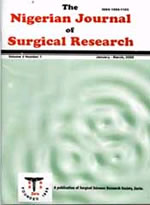
|
Nigerian Journal of Surgical Research
Surgical Sciences Research Society, Zaria and Association of Surgeons of Nigeria
ISSN: 1595-1103
Vol. 6, Num. 1-2, 2004, pp. 73-75
|
Nigerian Journal
of Surgical Research, Vol. 6, No. 1-2, Jan-June, 2004, pp. 73-75
Letter to the Editor
Current
views on breast cancer imaging
A. A. Bajomo
Department of Radiology, Olabisi Onabanjo University Teaching Hospital,
Sagamu, P. O. Box 2108, Dugbe, Ibadan. E-mail: bayobajomo@yahoo.com
Code Number: sr04024
Breast
cancer is a common and deadly disease that metastasizes early in its natural
history and may recurlater. 1 It shows
an incidence that increases with age. The disease is extremely rare in
males, accounting for approximate 0.7% of all cases. 2 Multidisciplinary
teams that compromise breast surgeons, radiologists, pathologists and oncologists,
should provide appropriate breast cancer management. 1 Radiological
imaging methods available for the diagnostic work-up of breast cancer include
mammography, breast ultrasound and magnetic resonance imaging.
Mammography (MMG)
It was recognized more than
60 years ago that clinically occult breast cancer could be visualized on
radiography. 3 Technical developments in film-screen MMG coupled
with evidence suggesting that MMG screening resulted in a reduction on
breast cancer mortality4, 5 led to the introduction and wide
acceptance of screening MMG in several western countries by the 80s. Screening
MMG aims to diagnose breast cancer early and is advocated in women above
50. The accuracy and positive predictive value of MMG are higher in older
than in younger women. 6 This may be related to the higher frequency
of the disease and the reduced breast density on MMG seen with increasing
age. There is no agreement on the case for breast cancer screening in
women aged <50 as higher false positive rate in younger women6 often
leads to unnecessary patient anxiety.
More cases of ductal carcinoma in-situ (DCIS) are being diagnosed with
improved MMG technology especially in younger women. 7 and currently
there is concern that these lesions are being treated too aggressively
as more than half may never become invasive or metastasise. Results, in
late 2004, are expected to show whether digital MMG is as sensitive, specific
and more cost effective than film MMG, and whether it will be able to obviate
unnecessary biopsies. 9, 10
Breast ultrasound (USS)
The accepted role of ultrasound
is as an adjunct to mammography, and it has been advocated as a tailored
examination to assess an area of mammographic and/or palpable abnormality
rather than as a complete survey of the breasts. 1 It has a
poor spatial resolution in that microcalcifications in tumours are poorly
detected. However, whole breast USS has been recently shown to be of value
in the detection of multicentric and multifocal cancer when used pre-operatively
in situations where breast conservation surgery is contemplated. 12 USS
is the initial method of choice in younger women with breast symptoms because
it does not involve radiation. It is 96-100% accurate in the diagnosis
of cysts, which constitute some 25% of all palpable or mammographically
detectable lesions. 13 However, current USS equipment is also
able to detect malignant microcalcifications 14 and is able
to show axillary nodal involvement. Breast USS is increasingly sued in
image-guided breast procedures such as tine needle aspiration cytology,
biopsies and hook-wire localization of lesions prior to surgical excision.
Magnetic resonance imaging (MRI)
The ability of contrast enhanced
MRI to demonstrate breast cancer was first reported by Hewang et al. 15 Most
authors subsequently report high sensitivity exceeding 98% in breast cancer
detection using contrast MRI, with much lower specificity because some
design lesions also enhance. 16
There are controversial issues regarding the benefits derived from mammography,
while exciting developments in Breast MRI promise more accurate imaging
in staging breast cancer and monitoring treatment response.
A. A. Bajomo
Department of Radiology,
Olabisi Onabanjo University Teaching Hospital, Sagamu, P. O. Box 2108,
Dugbe, Ibadan. E-mail: bayobajomo@yahoo.com
REFERENCES
-
Forrest APM. Breast cancer
100 years on – what we have learnt. Med J Malaysia 1996; 51: 767-773.
-
Wilhelm MC, Wanebo HJ. Cancer
of the male breast. Comprehensive management of benign and malignant diseases.
In: Bland KI, Copeland M (eds). Saunders, Philadelphia. 1991; 1030-1033.
-
Gershon – Cohon J, Strickler
A. Roentgenological examination of the normal breast; its value in demonstrating
early neoplastic change. AJR 1939; 40: 189-201.
-
Nystrom L et al. Breast
cancer screening with 2 mammography. Lancet 1993; 341: 973-978.
-
Tabar L, Gad A. Reduction
in mortality from breast cancer after mass screening with mammography. Lancet
1985; 82:32.
-
Fletcher SW. Why question
screening mammography for women in their forties. Radiol Clin Nor
Am 1995; 33: 1259-1271.
-
Kerlikowske K. Positive predictive
value of screening mammography by age and family history of breast
cancer. JAMA
1993; 270: 2444-2450.
-
Gorman C. Rethinking breast
cancer. Time 2002; 159: 30-38.
-
RSNA News. ‘Diagnosing’ the
effectiveness of digital mammography, 2002; 12(r): 8-9.
-
Pisano ED. The American College of Radiology
Imaging Network’s Digital Mammography Screening Trial. J Women’s Imaging
2001; 3: 58-59.
-
Jackson VP. The current role of ultrasonography
in breast imaging. Radiol Clin Nor Am 1995; 33: 1161-1170.
-
Berg WA, Gilbreath PL. Multicentric and multifocal
cancer: whole breast US in preoperative
evaluation. Radiology 2000; 214: 59-66.
-
Dennis MA, Marker SH. Breast biopsy avoidance. The
value of normal mammograms and normal sonograms in the setting of a palpable
lump. Radiology 2001; 329:186-191.
-
Starros AT. Solid breast nodulesi. Use of
sonography to distinguish between benign and malignant lesion. Radiology
1995; 1961:123-134.
-
Heywang SH. MR imaging of the breast using
gadolinium – DPTA. J Cat 1986; 10:199-204.
-
Viehwg P. Contrast-enhanced magnetic resonance
imaging of the breast. Top MRI 1998; 9: 17-43.
Copyright 2004 - Nigerian Journal of Surgical Research
|
